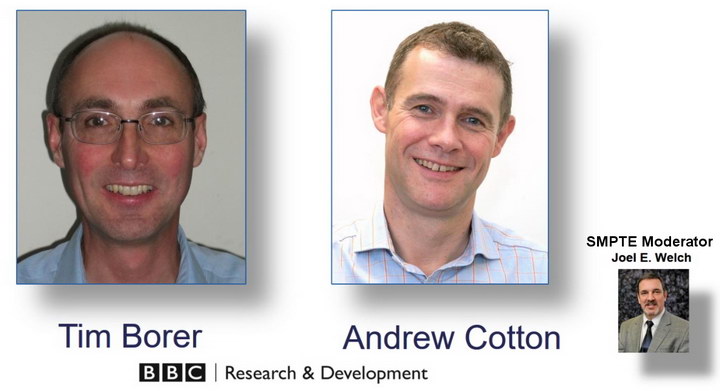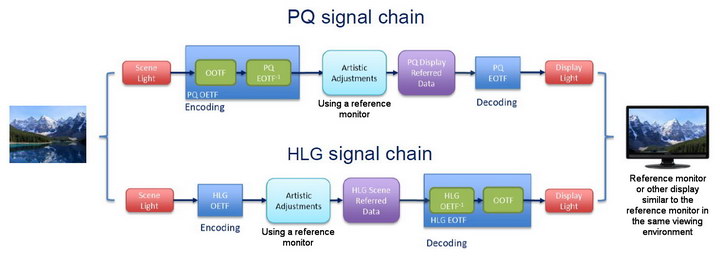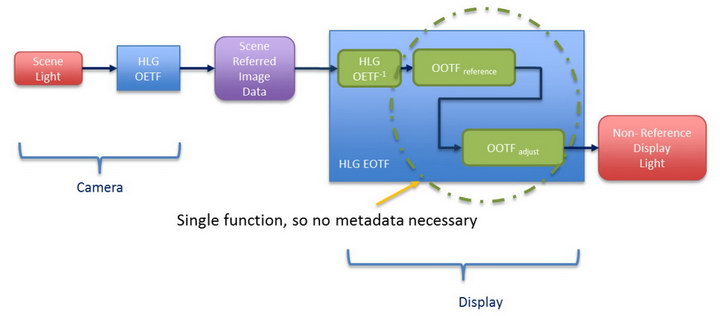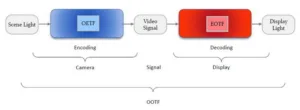I have written multiple articles for Display Daily about high dynamic range (HDR) cinema and TV, as have other Display Daily authors. Most of these articles have been from the Dolby Vision/HDR 10 point of view and both of these systems use the Perceptual Quantizer (PQ) system, which has been standardized as SMPTE ST 2084. (But not all, Matt, – see BBC Approach to HDR Has Advantages for Broadcasters– BR)

After listening to Dolby and other supporters of these systems, I sometimes wondered why the Hybrid Log-Gamma (HLG) system even existed and what chance it had in the television marketplace.
I attended a SMPTE webinar on January 19th presented by Tim Borer, a Lead Engineer at BBC Research and Development, and Andrew Cotton, a Principal Technologist at BBC Research and Development. These two gentlemen gave a clear and concise explanation of the advantages of the HLG system.

One thing that must be understood is that both PQ and HLG are Systems, not simply transfer curves. These systems are both designed to get an image from light at the original scene going into a camera transferred to light coming out of the final display while preserving the artistic intent of the content creators. This article will focus on the system aspects, not the details of the HLG and PQ transfer curves.
Another thing to be understood is the PQ system was developed by Dolby, a company whose main focus is on the cinema while the HLG system was developed jointly by BBC and NHK, two organizations whose main focus is on television.
Finally, there are three terms that must be used in trying to explain the difference between the PQ and HLG systems:
- OETF: Opto-Electronic Transfer Function. This is the non-linear relationship between the light falling on the camera sensor and the digital electronic signal generated by the camera.
- EOTF: Electro-Optical Transfer Function. This is the non-linear relationship between the digital electronic signal received by the display and the light emitted by the display.
- OOTF: Optical-Optical Transfer Function. This is the overall relationship between the light falling on the image sensor and the light coming out of the display.
The OOTF relationship is not normally linear in a camera-to-display signal chain and is often characterized by a Gamma value. One key to understanding the PQ vs HGL issue is the OOTF gamma value preferred by viewers and content creators varies with viewing conditions, which include both display brightness and the ambient surround light when the display is being viewed.
Generic End-to-End Video Chain Showing the OETF, EOTF and OOTF Functions.
In the cinema, the end-user viewing conditions are typically well controlled. The display brightness is specified, 48 cd/m² (nits) for normal cinema content and the ambient surround light is kept very low. Dolby Cinema HDR theaters maintain a higher brightness than this, in the range of 75 – 106 cd/m². Still, this is very low for television which is normally viewed in higher ambient light. Standard dynamic range (SDR) TVs are normally in the 200 – 300 cd/m² range although some are brighter.
SDR handheld devices are often in the 600 cd/m² range. The current generation of HDR televisions are in the 1000-2000 cd/m² range and Dolby Vision, the 12 bit proprietary Dolby adaptation of the PQ system to TV signals, allows displays up to 10,000 cd/m². Clearly, content mastered for a 48 or 100 cd/m² display needs to have the OOTF adjusted for the much brighter television displays which are normally viewed in a much brighter environment. Dolby Vision and HDR-10, the 10-bit non-proprietary adaptation of the PQ system, do this by sending metadata along with the video signal to tell the display how the content was mastered.
The display then adjusts the EOTF to provide the overall OOTF that best accommodates the difference between the brightness and viewing environment of the display used to master the content and the display used to view the content. The goal of this accommodation is to preserve the artistic intent of the content creators even when the content is seen by the viewer under different conditions than used by the content creators.
 PQ and HGL signal chains when the end-user viewing environment matches the viewing environment used in the editing process. No signal adjustment is needed for either the PQ signal chain or the HLG signal chain and both produce comparable image quality. Note that in the PQ system, the OOTF is embedded in the encoding section but in the HLG system the OOTF is embedded in the decoding section.
PQ and HGL signal chains when the end-user viewing environment matches the viewing environment used in the editing process. No signal adjustment is needed for either the PQ signal chain or the HLG signal chain and both produce comparable image quality. Note that in the PQ system, the OOTF is embedded in the encoding section but in the HLG system the OOTF is embedded in the decoding section.
PQ and HLG signal chains when the end-user viewing environment matches the viewing environment used in the editing process. No signal adjustment is needed for either the PQ signal chain or the HLG signal chain and both produce comparable image quality.
This approach was called “Display-Referred” by the webinar presenters. The video signal contains the information on how bright the display should be. In the PQ system, or any other display-referred system such as DCI or ACES, the electronic signal tells the display how manycd/m² to display and what color those nits should be for each pixel. This is the way film worked so it is not unreasonable for the digital cinema developers to try to match film.
 When a PQ signal is shown on a display where the display and display environment does not match the mastering display, the OOTF is adjusted using metadata from the mastering environment.
When a PQ signal is shown on a display where the display and display environment does not match the mastering display, the OOTF is adjusted using metadata from the mastering environment.
In a display-referred TV system, content mastered on a 2000 cd/m² professional display and shown on a 1000 cd/m² consumer TV would simply crush all white levels above 1000 cd/m², if no adjustment is done. This is not acceptable and this is where the metadata is needed, to adjust the signal at the display to the different display.
Television, on the other hand, has always been a “Scene-Referred” system. That is, the video signal contains the image information based on the brightness and color of the original scene at each pixel. In a scene-referred system such as analog TV or SDR HDTV, the final display can compare the brightness of the scene to the brightness of the end user display and adjust the OOTF gamma without needing any metadata saying what the brightness or viewing environment of the mastering display was. In this system, the electronics in the TV set can adjust the OOTF of the video for the end user display purely on the basis of local data, including display properties and ambient light.
 When a HLG signal is shown on a display where the display and display environment does not match the mastering display, the OOTF is adjusted using local data based on the viewing environment and the display properties. No metadata from the mastering environment is needed.
When a HLG signal is shown on a display where the display and display environment does not match the mastering display, the OOTF is adjusted using local data based on the viewing environment and the display properties. No metadata from the mastering environment is needed.
The HLG system has an additional advantage over the PQ system. Since the HLG OETF is similar to the OETF of SDR TV and there is no metadata to be accommodated, every HDR video signal encoded by the HLG system is automatically backward compatible with SDR TVs. Not just the TVs, but all the post production, data storage, editing and streaming hardware and software in the content creation and distribution industries. According to the webinar presenters, the only HDR-specific software or hardware needed to convert a SDR workflow into a HDR workflow is a HDR camera and a HDR mastering display.
Unlike the HLG system, the PQ system is not automatically backward compatible with SDR HDTV. There are backward-compatible versions of the PQ system, but these systems are based on a SDR base layer and then additional metadata to provide the HDR enhancement. A SDR TV will show the base SDR data as a normal SDR image and ignore the added HDR metadata. In one sense, this is an example of the problem, not a solution to it: too many segments of the television content creation, distribution, broadcast and display chain ignore the metadata and do not pass it on to where it is needed.
Both the HLG and PQ encoding/decoding schemes are included in the ITU-R Recommendation BT.2100. They are also both included in ARIB STD-B32, DVB/ETSI TS 101 154v2.3.1, future broadcasts in Korea and YouTube HDR. (No SMPTE webinar would be complete without a list of standards.) Cameras, editing software and professional and consumer displays from multiple vendors also both support both systems.
PQ Works Well For Cinema
While the PQ system works very well for the application it was designed for, cinema, it is not so good when used in a very different application, television. The very wide viewing conditions for “Television” content, including screen size, screen brightness and ambient light, make adjusting the overall OOTF essential in TV. PQ can do this through the use of metadata. However, I consider this a “kludge” rather than a fundamental system design advantage. Television is probably better served by the HLG system that was designed from the ground up by television engineers for the special requirements of television on multiple display platforms.
Currently much HDR content is mastered for the PQ system. According to the webinar speakers, there is no problem transcoding content from the PQ system to the HLG system or vice versa and there is no noticeable loss of image quality. In particular, transcoding from PQ encoded cinema content to HLG-encoded TV content does not represent an image quality compromise. While it is relatively rare for anyone to want to transcode TV content back to big-screen cinema, this is also perfectly possible, too. –Matthew Brennesholtz

